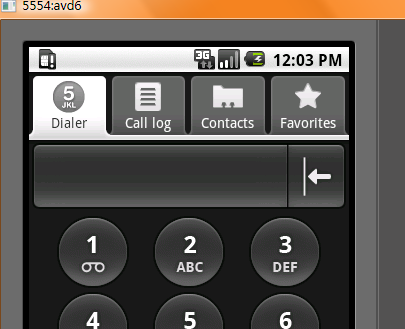Posted on 2009-11-18 15:44
疯狂 阅读(28886)
评论(12) 编辑 收藏 所属分类:
android 、
读代码

本文结合源代码和实例来说明TabHost的用法。
使用TabHost 可以在一个屏幕间进行不同版面的切换,例如android自带的拨号应用,截图:

查看tabhost的源代码,主要实例变量有:
 private TabWidget mTabWidget;
private TabWidget mTabWidget;
 private FrameLayout mTabContent;
private FrameLayout mTabContent;
 private List<TabSpec> mTabSpecs
private List<TabSpec> mTabSpecs 也就是说我们的tabhost必须有这三个东西,所以我们的.xml文件就会有规定:继续查看源代码:

 if (mTabWidget == null)
if (mTabWidget == null)  {
{
 throw new RuntimeException(
throw new RuntimeException(
 "Your TabHost must have a TabWidget whose id attribute is 'android.R.id.tabs'");
"Your TabHost must have a TabWidget whose id attribute is 'android.R.id.tabs'");
 }
}




 mTabContent = (FrameLayout) findViewById(com.android.internal.R.id.tabcontent);
mTabContent = (FrameLayout) findViewById(com.android.internal.R.id.tabcontent);

 if (mTabContent == null)
if (mTabContent == null)  {
{
 throw new RuntimeException(
throw new RuntimeException(
 "Your TabHost must have a FrameLayout whose id attribute is 'android.R.id.tabcontent'");
"Your TabHost must have a FrameLayout whose id attribute is 'android.R.id.tabcontent'");
 }
} 也就是说我们的.xml文件需要TabWidget和FrameLayout标签。
接下来构建我们自己的tab实例:
有两种方式可以实现:
一种是继承TabActivity 类,可以使用android的自己内部定义好的.xml资源文件作容器文件。也就是在我们的代码中使用getTabHost(); , 而相应的后台源码是这样的:
 this.setContentView(com.android.internal.R.layout.tab_content);
this.setContentView(com.android.internal.R.layout.tab_content); 在系统的资源文件中可以看见这个layout
有了容器,然后我们就需要我们为每个tab分配内容,当然要可以是如何类型的标签:
例如我们构建一下.xml文件
首先tab1.xml 是一个LinearLayout布局
 <?xml version="1.0" encoding="utf-8"?>
<?xml version="1.0" encoding="utf-8"?>

 <LinearLayout xmlns:android="http://schemas.android.com/apk/res/android"
<LinearLayout xmlns:android="http://schemas.android.com/apk/res/android"
 android:id="@+id/LinearLayout01" android:layout_width="wrap_content"
android:id="@+id/LinearLayout01" android:layout_width="wrap_content"
 android:layout_height="wrap_content">
android:layout_height="wrap_content">
 <TextView android:text="tab1 with linear layout"
<TextView android:text="tab1 with linear layout"
 android:id="@+id/TextView01" android:layout_width="wrap_content"
android:id="@+id/TextView01" android:layout_width="wrap_content"
 android:layout_height="wrap_content">
android:layout_height="wrap_content">
 </TextView>
</TextView>
 </LinearLayout>
</LinearLayout>
然后是tab2.xml是一个FrameLayout布局
 <?xml version="1.0" encoding="utf-8"?>
<?xml version="1.0" encoding="utf-8"?>
 <FrameLayout xmlns:android="http://schemas.android.com/apk/res/android"
<FrameLayout xmlns:android="http://schemas.android.com/apk/res/android"

 android:id="@+id/FrameLayout02"
android:id="@+id/FrameLayout02"
 android:layout_width="wrap_content"
android:layout_width="wrap_content"
 android:layout_height="wrap_content">
android:layout_height="wrap_content">
 <LinearLayout android:id="@+id/LinearLayout02"
<LinearLayout android:id="@+id/LinearLayout02"
 android:layout_width="wrap_content"
android:layout_width="wrap_content"
 android:layout_height="wrap_content">
android:layout_height="wrap_content">
 <TextView android:text="tab2"
<TextView android:text="tab2"
 android:id="@+id/TextView01" android:layout_width="wrap_content"
android:id="@+id/TextView01" android:layout_width="wrap_content"
 android:layout_height="wrap_content">
android:layout_height="wrap_content">
 </TextView>
</TextView>
 </LinearLayout>
</LinearLayout>

 </FrameLayout>
</FrameLayout>接着要注册这两个FrameLayout为tabhost的Content,也就是接下来的代码:
 LayoutInflater inflater_tab1 = LayoutInflater.from(this);
LayoutInflater inflater_tab1 = LayoutInflater.from(this);
 inflater_tab1.inflate(R.layout.tab1, mTabHost.getTabContentView());
inflater_tab1.inflate(R.layout.tab1, mTabHost.getTabContentView());
 inflater_tab1.inflate(R.layout.tab2, mTabHost.getTabContentView());
inflater_tab1.inflate(R.layout.tab2, mTabHost.getTabContentView());
然后需要构建前面说的tabhost的第三个实例变量对应得内容,源代码中是这样的:
 private List<TabSpec> mTabSpecs = new ArrayList<TabSpec>(2);
private List<TabSpec> mTabSpecs = new ArrayList<TabSpec>(2); 初始化是两个tab的空间然后会自动扩展:
好 我们构建我们的tabspec:
 mTabHost.addTab(mTabHost.newTabSpec("tab_test1").setIndicator("TAB 11").setContent(R.id.LinearLayout01));
mTabHost.addTab(mTabHost.newTabSpec("tab_test1").setIndicator("TAB 11").setContent(R.id.LinearLayout01));
 mTabHost.addTab(mTabHost.newTabSpec("tab_test1").setIndicator("TAB 11").setContent(R.id.FrameLayout02));
mTabHost.addTab(mTabHost.newTabSpec("tab_test1").setIndicator("TAB 11").setContent(R.id.FrameLayout02));
也就是把我们的2个layout作为他的content,当然FrameLayout中可以有其他的布局,来放我的组件。
我们不需要在代码里面设置setContentView();因为getTabHost(); 这个方法调用后就已经设置了,源代码:

 if (mTabHost == null)
if (mTabHost == null)  {
{
 this.setContentView(com.android.internal.R.layout.tab_content);
this.setContentView(com.android.internal.R.layout.tab_content);
 }
}也就是把系统的tab_content当做view设置。
运行后如下:

完整代码:
 TabHost mTabHost = getTabHost();
TabHost mTabHost = getTabHost();
 LayoutInflater inflater_tab1 = LayoutInflater.from(this);
LayoutInflater inflater_tab1 = LayoutInflater.from(this);
 inflater_tab1.inflate(R.layout.tab1, mTabHost.getTabContentView());
inflater_tab1.inflate(R.layout.tab1, mTabHost.getTabContentView());
 inflater_tab1.inflate(R.layout.tab2, mTabHost.getTabContentView());
inflater_tab1.inflate(R.layout.tab2, mTabHost.getTabContentView());
 mTabHost.addTab(mTabHost.newTabSpec("tab_test1").setIndicator("TAB 11").setContent(R.id.LinearLayout01));
mTabHost.addTab(mTabHost.newTabSpec("tab_test1").setIndicator("TAB 11").setContent(R.id.LinearLayout01));
 mTabHost.addTab(mTabHost.newTabSpec("tab_test1").setIndicator("TAB 11").setContent(R.id.FrameLayout02));
mTabHost.addTab(mTabHost.newTabSpec("tab_test1").setIndicator("TAB 11").setContent(R.id.FrameLayout02));
还有一种就是定义我们自己的tabhost:不用继承TabActivity
首先建立我们自己的.xml文件,当然要包含Tabhost,TabWidget,FrameLayout,着3个标签:
 <?xml version="1.0" encoding="utf-8"?>
<?xml version="1.0" encoding="utf-8"?>
 <TabHost xmlns:android="http://schemas.android.com/apk/res/android"
<TabHost xmlns:android="http://schemas.android.com/apk/res/android"
 android:id="@+id/tabhost"
android:id="@+id/tabhost"
 android:layout_width="fill_parent"
android:layout_width="fill_parent"
 android:layout_height="fill_parent">
android:layout_height="fill_parent">
 <LinearLayout
<LinearLayout
 android:orientation="vertical"
android:orientation="vertical"
 android:layout_width="fill_parent"
android:layout_width="fill_parent"
 android:layout_height="fill_parent">
android:layout_height="fill_parent">
 <TabWidget
<TabWidget
 android:id="@android:id/tabs"
android:id="@android:id/tabs"
 android:layout_width="fill_parent"
android:layout_width="fill_parent"
 android:layout_height="wrap_content" />
android:layout_height="wrap_content" />
 <FrameLayout
<FrameLayout
 android:id="@android:id/tabcontent"
android:id="@android:id/tabcontent"
 android:layout_width="fill_parent"
android:layout_width="fill_parent"
 android:layout_height="fill_parent">
android:layout_height="fill_parent">

 </FrameLayout>
</FrameLayout>
 </LinearLayout>
</LinearLayout>
 </TabHost>
</TabHost>

注意的是:除了tabhost的id可以自定义外,其他的必须使用系统的id,为什么后面说,
当然我们可以在FrameLayout里面添加view来作为tab的内容只需要在create tabspce时候添加就可以了,我们为了把每个tab的内容分开我们依然使用前面用到的两个tab xml文件
java代码:
获取TabHost 通过findviewbyid,
 setContentView(R.layout.main);
setContentView(R.layout.main);
 TabHost mTabHost = (TabHost)findViewById(R.id.tabhost);
TabHost mTabHost = (TabHost)findViewById(R.id.tabhost); 接下来很重要的一步是要使用TabHost.setup();
作用是来初始化我们的TabHost容器:
源代码是这样说的:
 <p>Call setup() before adding tabs if loading TabHost using findViewById(). <i><b>However</i></b>: You do
<p>Call setup() before adding tabs if loading TabHost using findViewById(). <i><b>However</i></b>: You do

 * not need to call setup() after getTabHost() in
* not need to call setup() after getTabHost() in  {@link android.app.TabActivity TabActivity}.
{@link android.app.TabActivity TabActivity}. 也就是说通过findviewbyid,方法获得tabhost必须setup 而通过getTabHost则不用。
setup干什么呢:源代码
 mTabWidget = (TabWidget) findViewById(com.android.internal.R.id.tabs);
mTabWidget = (TabWidget) findViewById(com.android.internal.R.id.tabs);

 if (mTabWidget == null)
if (mTabWidget == null)  {
{
 throw new RuntimeException(
throw new RuntimeException(
 "Your TabHost must have a TabWidget whose id attribute is 'android.R.id.tabs'");
"Your TabHost must have a TabWidget whose id attribute is 'android.R.id.tabs'");
 }
}


 mTabContent = (FrameLayout) findViewById(com.android.internal.R.id.tabcontent);
mTabContent = (FrameLayout) findViewById(com.android.internal.R.id.tabcontent);

 if (mTabContent == null)
if (mTabContent == null)  {
{
 throw new RuntimeException(
throw new RuntimeException(
 "Your TabHost must have a FrameLayout whose id attribute is 'android.R.id.tabcontent'");
"Your TabHost must have a FrameLayout whose id attribute is 'android.R.id.tabcontent'");
 }
} 他主要是初始化了tabhost的两个实例变量,这里也回答了为什么我们的id必须使用系统定义的id的原因
接下来工作就和前面相同了:
 LayoutInflater inflater_tab1 = LayoutInflater.from(this);
LayoutInflater inflater_tab1 = LayoutInflater.from(this);
 inflater_tab1.inflate(R.layout.tab1, mTabHost.getTabContentView());
inflater_tab1.inflate(R.layout.tab1, mTabHost.getTabContentView());
 inflater_tab1.inflate(R.layout.tab2, mTabHost.getTabContentView());
inflater_tab1.inflate(R.layout.tab2, mTabHost.getTabContentView());
 mTabHost.addTab(mTabHost.newTabSpec("tab_test1").setIndicator("TAB a").setContent(R.id.LinearLayout01));
mTabHost.addTab(mTabHost.newTabSpec("tab_test1").setIndicator("TAB a").setContent(R.id.LinearLayout01));
 mTabHost.addTab(mTabHost.newTabSpec("tab_test2").setIndicator("TAB b").setContent(R.id.FrameLayout02));
mTabHost.addTab(mTabHost.newTabSpec("tab_test2").setIndicator("TAB b").setContent(R.id.FrameLayout02));
完整代码:
 setContentView(R.layout.main);
setContentView(R.layout.main);
 TabHost mTabHost = (TabHost)findViewById(R.id.tabhost);
TabHost mTabHost = (TabHost)findViewById(R.id.tabhost);
 mTabHost.setup();
mTabHost.setup();
 LayoutInflater inflater_tab1 = LayoutInflater.from(this);
LayoutInflater inflater_tab1 = LayoutInflater.from(this);
 inflater_tab1.inflate(R.layout.tab1, mTabHost.getTabContentView());
inflater_tab1.inflate(R.layout.tab1, mTabHost.getTabContentView());
 inflater_tab1.inflate(R.layout.tab2, mTabHost.getTabContentView());
inflater_tab1.inflate(R.layout.tab2, mTabHost.getTabContentView());
 mTabHost.addTab(mTabHost.newTabSpec("tab_test1").setIndicator("TAB a").setContent(R.id.LinearLayout01));
mTabHost.addTab(mTabHost.newTabSpec("tab_test1").setIndicator("TAB a").setContent(R.id.LinearLayout01));
 mTabHost.addTab(mTabHost.newTabSpec("tab_test2").setIndicator("TAB b").setContent(R.id.FrameLayout02));
mTabHost.addTab(mTabHost.newTabSpec("tab_test2").setIndicator("TAB b").setContent(R.id.FrameLayout02));
运行结果同上。 如有问题欢迎提出。
转载请说明出处。。。
加上源代码,有用了可以下载下:/Files/freeman1984/atab.rar